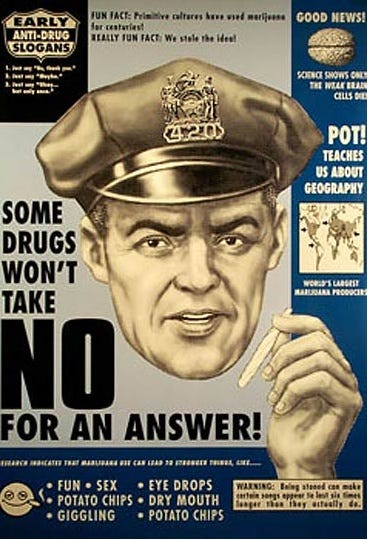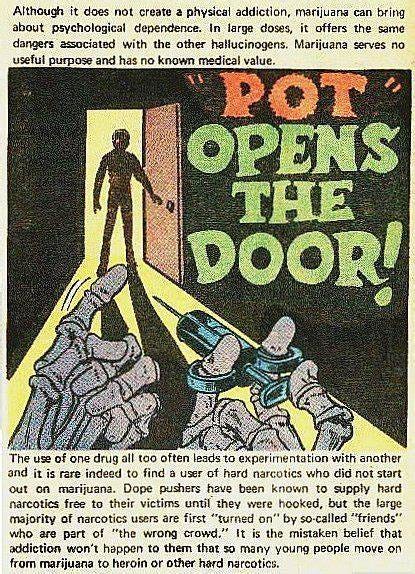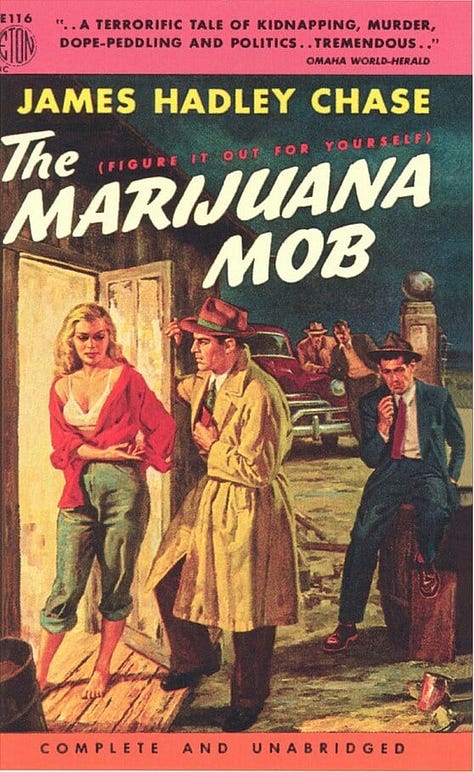DARE to Question: How Decades of Drug Propaganda Shaped Public Perception
People are more likely to join your cause if you know how to twist the story…
Despite the research, changing laws, and social shift, many people have a hard time seeing any psychoactive substances as anything but dangerous — thanks to decades of political campaigns (propaganda) conditioning us to “Just Say No.”
Remember the TV commercial showing an egg on a frying pan (“This is your brain on drugs…”)?
No? Maybe I’m just that old.
Regardless, the iconic public service announcement from the PDFA (Partnership for a Drug-Free America) certainly stuck in impressionable young minds.
Go ahead and watch the commercial, and then — for kicks — watch this remake from Rachael Leigh Cook (who starred in 1997’s real version) called “Your Brain on Drug Policy.”
The anti-drug push started way before that commercial first aired — but we weren’t always so strict. For example, at the end of the 1800s, we, as a nation, could buy heroin and cocaine from the Sears Roebuck catalog (two vials of heroin graciously came in a kit with a syringe and two needles, all for $1.50).
Within a few short decades, opiates, cocaine, and morphine became regulated, and in 1919, the government made the decision to outlaw alcohol (which was overturned in 1933).
Marijuana followed suit in 1937. The Controlled Substance Act of 1970 sealed the deal, banning all of the scary, culture-decaying substances (minus alcohol, of course).
The Real Reasons Behind the War on Drugs
How did we go from one extreme to the other in such a short period of time?
No, the answer is not knowledge and a deep sense of responsibility for future generations.
The reality is that those laws were based more on fear, pride, and prejudice than anything noble.
Effective propaganda makes you feel like you’re doing the right thing without stopping to think about it. And you do that “right thing” with gusto. I’d wager most people pushed the anti-drug agenda with pure motives, but history shows horrendous things can be done with good intentions.
It’s true we knew very little about those controlled substances, but that’s exactly why we may have jumped the gun a little.
Why lock something down, making it inaccessible even for research, if you aren’t even sure what it’s capable of?
President Nixon officially declared a war on drugs in 1971 and created the Drug Enforcement Agency (DEA) in 1973, which now receives billions in federal funding every year. To date, the program has cost US taxpayers more than 1 trillion dollars — yet has achieved shockingly little.
Despite the enormous financial investment, the war on drugs has had minimal impact on reducing drug abuse. According to the National Institute on Drug Abuse (NIDA), drug overdoses have only increased over the past decades — not decreased.
If you’re beginning to wonder why the government would go out of its way to sink money into ineffective policies and mass incarceration — good. Keep reading.
We might not ever know, but here’s something to consider:
John Ehrlichman, Assistant to the President for Domestic Affairs under President Richard Nixon, said in an interview:
“You want to know what this [war on drugs] was really all about? The Nixon campaign in 1968, and the Nixon White House after that, had two enemies: the antiwar left and black people. You understand what I’m saying? We knew we couldn’t make it illegal to be either against the war or black, but by getting the public to associate the hippies with marijuana and blacks with heroin, and then criminalizing both heavily, we could disrupt those communities. We could arrest their leaders, raid their homes, break up their meetings, and vilify them night after night on the evening news. Did we know we were lying about the drugs? Of course we did.”
Jimmy Carter campaigned to decriminalize marijuana, and between 1973 and 1977, eleven states actually did. But President Reagan brought the focus back to drugs and expanded on Nixon’s policies, leading to the Anti-Drug Abuse Act in 1986, which created severe, minimum mandatory sentences for drug offenses. This led to a huge increase in incarcerations for non-violent crimes, largely among the black population.
Drug Propaganda & the Good Cause
To get the masses to agree to the campaign, you need to find a common ground. Something everyone can support. It’s even better if that purpose is so pure that people will sound crappy if they don’t stand behind it.
Also, fear — it’s a great motivator. All good propaganda has some good ol' fashioned fear baked in somewhere.
It didn’t take much to get the ball rolling (it’s still going!), thanks to the perfect recipe — innocent kids, deadly substances, and predators set out to lure them in and destroy their futures.
People are still scared of strangers giving their kids drugs. Look at Halloween and how scared parents are of drugged candy. While there are douche-bags that would do that to kids, most don’t want to give away their stash. Drugs are expensive.
Nancy Reagan’s Just Say No advertising campaign ran in the 1980s and early 90s and was meant to educate kids and arm them with the ability to stay away from drugs.
D.A.R.E. (Drug Abuse Resistance Education) was started in 1983 and has been implemented in schools across the nation.
The National Family Partnership started the Red Ribbon Campaign in 1985 and is still going strong today.
In 1997, the Office of National Drug Control Policy (ONDCP) received funding for a large-scale media campaign to essentially do the same thing — teach kids about the dangers of drugs.
There are endless efforts from both the government and the public, but most are cringy and ineffective at best.
Some favorites include McGruff the Crime Dog’s song saying, “Users are losers and loser are users…”, Peewee Herman sharing his thoughts on crack, and other commercials that play into racial stereotypes or a kid’s worst fears.
Of course, parents weren’t off the hook, as this one made it clear that “Parents who use drugs have kids who use drugs.”
Anti-drug groups are still prevalent, and their message doesn’t seem to have changed.
When Does “Good” Become “Bad”?
Don’t misread what I’m saying here. I have no problem teaching kids, or anyone else, about the dangers of drugs. I’m not saying these programs are inherently bad or wrong. I’m not okay with teens using weed or alcohol.
I am pro-common sense, using facts to come to conclusions and being slow to take action. I am saying maybe there’s more to the anti-drug laws than we know, and that the fear surrounding most of the Schedule I substances is misplaced. We could be much further along in our research and have access to much-needed drugs if it weren’t for fear-based legislation.
Important Research Came to a Halt
Research on Schedule I drugs has been sparse thanks to strict laws, but we’re seeing an influx of studies now, and guess what?
Quite a few of these substances with supposedly "no medical use" and are "highly addictive" (the Schedule I definition) show great potential medically, have a low risk for addiction, and look like they’re far safer than the prescription alternatives that are legal.
Marijuana could help reduce chronic and neuropathic pain, epilepsy, cluster headaches, and more.
Psychedelics could help treat addiction and psychiatric disorders like depression, anxiety, and PTSD.
And this is just the beginning. We don’t know what else these substances can do because we aren’t allowed to study them.
The National Library of Medicine has this to say:
“Although there is a general public perception that psychedelic drugs are dangerous, from a physiologic standpoint, they are, in fact, one of the safest known classes of central nervous system (CNS) drugs. They do not cause addiction, and no overdose deaths have occurred after ingestion of typical doses of LSD, psilocybin, or mescaline.”
Ironically, this is exactly what people like Timothy Leary and Albert Hofmann have said from the beginning, but we ignored their research and halted all progress.
People’s Lives = Collateral Damage
The problems don’t stop here… The War on Drugs has done nothing but create bigger problems.
For starters, it’s expensive, deters people from getting help and keeps them in poverty. Drug prohibition has played a major role in creating the drug cartel, and makes the drugs themselves more dangerous. Statistics show the threat of long-term prison sentences hasn't slowed drug supply.
The number of people locked up or whose lives have been destroyed because of these laws is staggering. You can place the blame on the individuals for breaking the law, but that’s a very narrow (and frankly, harmful) mindset. Let’s not excuse the overreaching government and dirty politics.
There Are Two Sides to the Story
We can’t change the past, but we can look toward the future. We can’t change how other people think and act, but we can take responsibility for how we respond to the information thrown at us.
We either accept it without thought or we analyze it and see what’s true or false. We either jump on the bandwagon and throw ourselves into the next “good cause,” or we take the time to digest the information and consider the implications.
As adults, we should think for ourselves, but that means being aware of confirmation bias. We tend to seek out information that agrees with what we already believe and deny anything contrary. We usually do this subconsciously, which means it can be hard to detect. This is why we have to slow down when we’re confronted with anything new.
It also means looking at both sides of the story and considering other perspectives. We have no excuse these days. The world is at our fingertips, and having discussions/digging deeper has never been easier.
Propaganda?!? Where?
We also need to be able detect alternative agendas. So, how do we spot propaganda, for next time? Because there will be a next time.
Look at the source and who’s behind the source. Is more than one viewpoint fairly represented? Read up on the topic. Separate the facts from the opinions and emotions. And possibly, most importantly, does it stir up prejudices, fear, and/or hatred?
If we had applied this when confronted with the drug legislation in the beginning, maybe we could have come up with an alternative that wouldn’t have ruined so many lives and set us back for decades. After all, once laws (and mindsets) are in place, they’re incredibly hard to undo.






Drug Propaganda Commercials
Further Reading
Enjoying Tripsitter? 🍄❤️
Don’t Journey Alone! Tripsitter was built by a community of psychedelic advocates — but it’s people like you that enable us to thrive.
If you found this newsletter insightful, share the love ❤️ using the link below.









